In this article “Dipole dipole forces examples” , the example of two types of dipole moment is described below.
In Chemistry two types of dipole-dipole forces exist.
- Permanent dipole-dipole forces
- Dipole-induced dipole force
Permanent dipole-dipole interaction forces-
Dipole-Induced Dipole Forces-
Permanent dipole- dipole forces
Dipole moment of any molecular species can be calculated by the formula written below.
Dipole moment= Charge× Internuclear separation.
Unit of dipole moment is Debye.
To know more please follow: 5 Polar Covalent Bond Examples: Detailed Insights And Facts
Permanent Dipole Dipole Forces Examples
Water molecule
Water molecule contains two different atoms, oxygen and hydrogen, having a large difference in electronegativity. So, it must have a permanent and strong dipole moment (1.85 D). Its positive and negative charge are not centered on one atom, rather it is separated in a small distance. Due to this high dipole moment water is widely used as polar protic solvent.
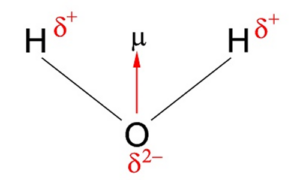
Image Credit: Wikimedia Commons
Hydrogen Chloride
In HCl molecule, a large electronegativity difference exists between hydrogen and chlorine. Charge separation is also there in this molecule. The positive end (hydrogen part) of one HCl molecule attracts the negative part (chlorine part) of another molecule. Thus, it possesses a strong dipole moment (1.08D).
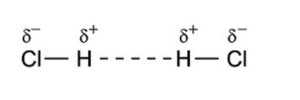
Image Credit: Wikimedia Commons
Ozone
Ozone molecule has a permanent dipole moment due to its bent structure and lone pairs on the central oxygen atom. Central oxygen atom has positive charge whereas the terminal oxygens possess negative charge, Thus it has a permanent dipole moment of 0.53D.
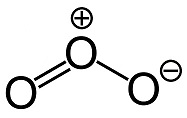
Image Credit: Wikimedia Commons
Sulfur Tetrafluoride (SF4)
SF4 is a polar molecule having permanent dipole moment 0.632D. Sulfur atom consists lone pair and due to this SF4 cannot achieve symmetrical geometry. Fluorine is more electronegative than sulfur so an uneven charge distribution occurs in SF4 molecule.
Sulfur Dioxide (SO2)
Due to the lone pair on sulfur atom, SO2 cannot attain linear structure like carbon dioxide (O=C=O). It has bent like structure (1200). This structure makes SO2 a polar molecule and the dipole moment arising due to the electronegativity difference between sulfur and oxygen can not be cancelled out by each other. Thus, it has a strong permanent dipole moment (1.62D).

Image Credit: Wikimedia Commons
Ammonia (NH3)
In ammonia, the central atom nitrogen is sp3 hybridizes and attain a trigonal pyramidal geometry with lone pair on nitrogen. Due to this unsymmetrical structure and electronegativity difference between nitrogen and hydrogen NH3 possesses a strong permanent dipole moment of 1.4D.
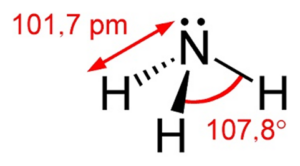
Image Credit: Wikimedia Commons
Hydrogen Sulfide
Hydrogen Sulfide has similar structure with water with slight different bond angle. It has also bent structure and lone pair on sulfur atom. A huge electronegativity is also there between hydrogen and sulfur. The vector sum of the S-H bond dipole produces overall non zero dipole moment.
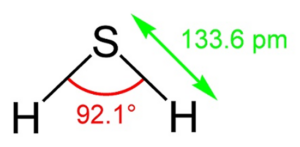
Image Credit: Wikimedia Commons
To know more please check: 10 Ionic Bond Examples: Explanation And Detailed Facts
Dipole-Induced Dipole Forces
A dipole-induced dipole attraction is weaker than permanent dipole-dipole interaction. It arises when a polar molecule induces an atom or any nonpolar molecule by polarising the electron charge cloud of the nonpolar species. Induced dipole
Moment depends upon the permanent dipole moment of the polar molecule and polarizability of the neutral molecule that is going to be induced by the polar molecule.
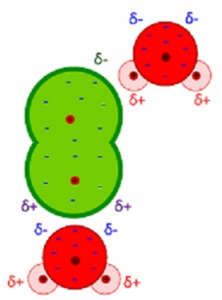
Image Credit: Wikimedia Commons
To know more please go through: Is Tetrahedral Polar: Why, When and Detailed Facts
Dipole-Induced Dipole Forces Examples
Hydrogen Chloride- Argon molecule
Hydrogen chloride is a polar molecule and Ar is a gaseous nonpolar molecule having zero dipole moment. Chlorine in HCl induces the positive electronic charge and hydrogen induces the negative part of Argon and creates a temporary dipole in the Argon molecule.
Water-Molecular Oxygen
Oxygen having greater electronegativity induces the positive end and hydrogen having partially positive charge induces the negative end in the neutral oxygen molecule. A temporary dipole is created by this unequal induction in O2 molecule by oxygen and hydrogen.
Water- Xenon Molecule
Water is a polar molecule. Oxygen bearing partial negative charge, induces the positive end of neutral xenon molecule and hydrogen having partial positive charge induces the negative part of Xe, and a temporary dipole moment is created in Xe atom. If the induction of water is removed then Xe returns to its neutral state and the dipole which is created will be destroyed.
To know more please check: N2 polar or nonpolar: Why, How, Characteristics, And Detailed Facts
Frequently Asked Questions (FAQ)
Some frequently asked questions about dipole moment with answers are discussed below.
How do dipole moments cancel out?
Answer: If any molecule possesses any symmetrical structure the bond dipole moment will be cancelled out by each other, Then the molecule behaves as a nonpolar species.
What makes dipole moment stronger?
Answer: Greater difference in electronegativity between the consisting atoms of a molecular species increases the dipole moment of the molecule.
How many types of dipolar interaction exist in Chemistry?
Answer: Three types of dipolar interaction is there.
1.Permanent dipole- permanent dipole interaction
2.Permanent dipole-induced dipole interaction.
3.Induced dipole-induced dipole interaction.
Can you Explain the Relationship between Dipole-Dipole Forces and Intermolecular Forces?
Dipole-dipole forces are a type of intermolecular force that exist between polar molecules. These forces occur due to the attraction between the positive end of one molecule and the negative end of another. They play a vital role in determining the physical properties of substances, like boiling and melting points. Understanding intermolecular forces and their explanations helps clarify how these attractive forces influence the behavior of molecules and their interactions.
Why does dipole moment increase with increasing with distance?
Answer: When the internuclear separation increases (bond length increases) polarity between the atoms increase and dipole moment also increases.
What are the significances of measuring dipole moment?
Answer: Dipole moment helps to determine the shape of the molecule, dissolving ability, boiling and melting point and indirectly the reactivity with any particular component.
Also Read:
- Exothermic examples
- Double covalent bond examples
- Neutralization reaction examples
- Metathesis reaction examples
- Perfectly inelastic collision examples
- Triple bond examples
- Fluid friction examples
- Periodic motion examples
- Electrostatic force examples
- Pentagon shape examples

Hello,
I am Aditi Ray, a chemistry SME on this platform. I have completed graduation in Chemistry from the University of Calcutta and post graduation from Techno India University with a specialization in Inorganic Chemistry. I am very happy to be a part of the Lambdageeks family and I would like to explain the subject in a simplistic way.
Let’s connect through LinkedIn-https://www.linkedin.com/in/aditi-ray-a7a946202